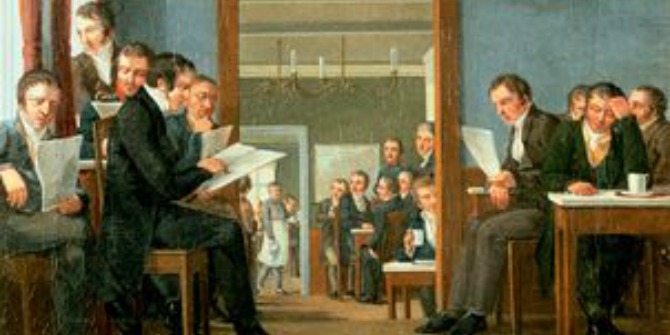
Inventing Peace differs considerably from the usual academic offerings on peace or IR, with film-maker Wim Wenders and philosopher Mary Zournazi reflecting on the need to reinvent our understandings of war and injustice. Inspired by various cinematic and artistic examples, Wenders and Zournazi engage in a provocative debate that will be of interest to those studying media and cinema, and to those looking for a new take on moving forward with peace, concludes Jade Montserrat.

Inventing Peace, co-authored by German film director, photographer, playwright and writer Wim Wenders, and Australian writer and philosopher Mary Zournazi, considers the need “to reinvent a visual and moral language for peace”, inspired by various cinematic, philosophical, literary, and artistic examples. Inventing Peace is a collaboration in the form of a written dialogue, conceived through an evidently pungent friendship between the two and their shared interest in “making peace visible in a new way”, believing that dialogue is “the artful process and flow between people that offers the potential for change” (p.11). No resolution is offered, naturally, leaving it up to readers to reflect alongside the duo on how to make peace visible and tangible in new ways.
Readers might respond by enquiring if peace is merely an ideal rather than an achievable prospect. As a practical gesture peace remains flimsy, utopian, and complicated, despite the contributions of academic literature and campaigns across the world. Highlighting the stalwarts devoted to imagining peace, or more characteristically, revealing the trauma of violence, injustices, and war, there is, quite naturally from the great filmmaker, an emphasis on ‘seeing’ and those who ‘see’, which is contextualized by Zournazi.
Inventing Peace opens with “A Prelude to Looking at Peace”, which describes how the writers met, following Zournazi listening to a radio interview with Wenders in which he reflected on his interest in peace. The challenge posed by the authors to the reader is clear in the first sentence: “much of our everyday thinking and language is bereft of how to imagine and talk about peace.” Here the authors précis their collaborative process and provide what might be described as a checklist in an ethical imagining, through teckne (Greek: arts, skills or crafts), for the future of the world.
Each of the five chapters is condensed through the use of sub-titles – making the writing somewhat like bite-sized musings. Inventing Peace differs considerably from an academic book on peace or IR and Politics, and readers should be aware of this. The novelty perhaps is the lightness of touch shared by both authors, emphasised by Wenders who writes in a unique style of prose that he describes as helping him to “see [his] thoughts” (p. 8). Throughout, Inventing Peace is laden with visual imagery, surfacing through Wenders and Zournazi’s textual sallying, inviting our imaginations to engage from an entwined consciousness. Wenders speaks from his own experiences as a filmmaker and includes many examples from cinema. Akira Kurosawa’s film Ran is described at some length, and is especially poignant in the modern parallels that the reader can make in beginning to “understand the logic of violence” (p. 113). Similarly, by citing Robert Bresson’s Au hasard Balthazar and Picasso’s Guernica, a creative approach to thinking about peace is illustrated in as much as such artists present divergent and tolerant viewpoints: “There is a way of seeing that can respond to violence without reproducing the trauma and paralysing others and ourselves” (p. 125).

Imagining Peace is set against the relentlessly spluttering fire of war. Smothering our dreams of peace is this abhorrent climate of fear that propagates by drifting on a stale and apathetic air: “we now accept horror as part of our human condition” (p.22), write the authors. In chapter 2 ‘Inventing Peace’, Wenders and Zournazi discuss whether their occupations and passions are theoretically effectual, which irregularly surfaces as a way of overcoming frustration. These bruised thoughts, however, ardently return to their conceptualisation of collaboration writ large to indulge their conversation: “Peace starts with listening” (p.39) and “One of the conditions of peace is to see…To really look is to move beyond indifference and cruelty, just as much as it is about accepting human capacity for violence and evil”(p.51). This chapter continues with Wenders speaking universally, of our “gargantuan kaleidoscope”, as urgently needing “to take possession of everything; ideas, objects, land, people” (p.58).
The effect of cinema globally is a well-trodden phenomenon and contentiously one surfacing under the auspices of hyper-reality. The ‘cinematic community’, for want of a better phrase, participates and is saturated by an imaginative force reckoning with our shared notion of time and space. Reading Inventing Peace equips the reader with a charter for re-enchanting our imaginations, demanding us “to respond to the radical uniqueness and presence of others in this world, and beyond our usual frontiers of understanding” (p. 109). Chapter 4, ‘Imagining the Real’, arises from the need to dislocate ‘showing’ violence from our understanding of the logic of violence. Bursts of enigmatic artists emerge from each page as “tools of perception”, including W. H. Auden, Jean Renoir, Pablo Picasso, and T. S. Eliot.
In chapter 3 ‘Enduring Images’, the authors search for resolution: Wenders is humble and apologetic, describing his “rambling thoughts” or writhing his way between connections, “but I can’t put my finger on it yet” (p. 62). Zournazi ardently blitzes his occasional sprawling dioramas of peace by arranging them and firmly interjecting with her ready ammunition of quotations. Inventing Peace recognises its limitations but it is built on pragmatic foundations. It is a generous invitation to participate in moulding a new horizon through dialogue and creativity, wonder and instinct, “in which we can observe and openly relate to others without fear or judgement” (p.87). It presents a connexion of salutary guidance, offering the means and potential for an evolutionary regression that embraces our technologically advanced world:
“Peace needs us to become children again, somehow, otherwise we can never even smell what peace is and immerse into it.” [p.98]
Inventing Peace poses questions (how else might it possibly function?) but through it readers will change their perception of the horror that surrounds us. From this perspective, the book presents readers with ethical decisions of which to make sense. In that respect, the reader might consider this a “rough-guide” to living in an era in which we are numbed to the ceaseless violence. Hope does remain pivotal, however, through their sympathetic tone, observing peace as “the imagining of a different world, but the world that already surrounds us – it is the making and unmaking of ritual and tradition in our everyday lives inasmuch as it is holy and sacred (p.4).”
—————————————-
Jade Montserrat is currently a resident artist at Crescent Arts, Scarborough. She read for a History of Art BA at the Courtauld Institute of Art, followed by an MA in Drawing at Norwich University College of Arts. Read more reviews by Jade.








1 Comments